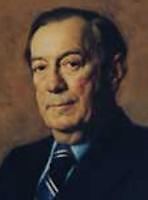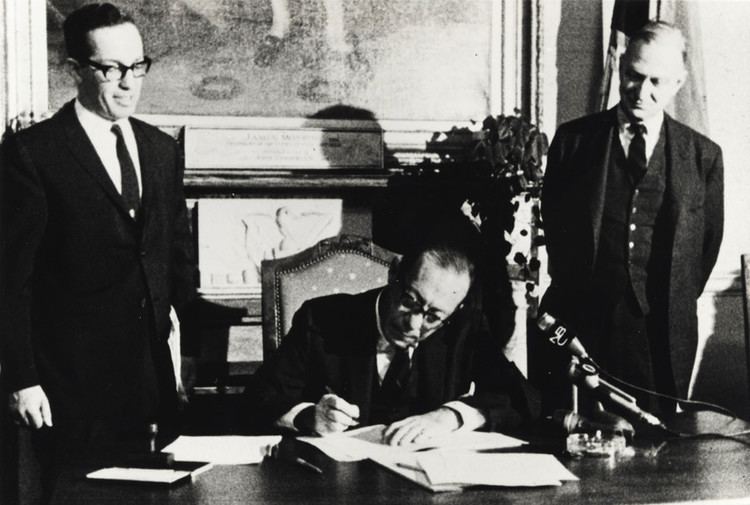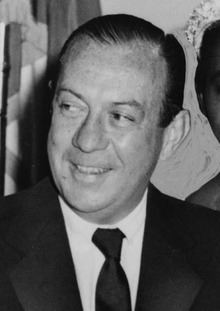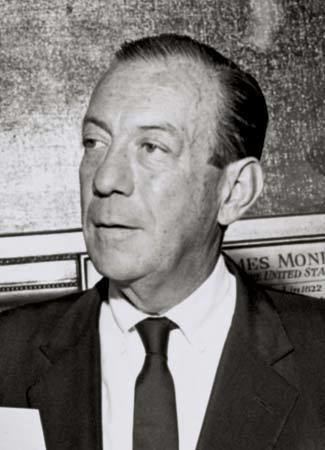Succeeded by John V. Lindsay Name Robert Wagner, Parents Robert F. Wagner | Children Robert F. Wagner, Jr. | |
 | ||
President Lyndon B. JohnsonRichard Nixon Spouse Phyllis Fraser (m. 1975–1991), Barbara Joan Cavanagh (m. 1965–1971), Susan Edwards (m. 1940–1964) Similar People Robert F Wagner, Phyllis Fraser, Bennett Cerf, Christopher Cerf | ||
Robert F. Wagner Interview on the History of John Jay College
Robert Ferdinand Wagner II (April 20, 1910 – February 12, 1991), usually known as Robert F. Wagner Jr. served three terms as the mayor of New York City, from 1954 through 1965. When running for his third term, he broke with the Tammany Hall leadership, ending the reign of clubhouse bosses in city politics.
Contents
- Robert F Wagner Interview on the History of John Jay College
- Whats My Line Mayor Robert F Wagner Jr Jan 3 1954
- Life and early career
- Mayor
- Ambassador
- Personal life
- Death and legacy
- References

What's My Line? - Mayor Robert F. Wagner, Jr (Jan 3, 1954)
Life and early career
Wagner was born in Manhattan, the son of Margaret Marie (McTague) and German-born United States Senator Robert Ferdinand Wagner I. He attended Taft School and graduated from Yale University in 1933, where he was on the business staff of campus humor magazine The Yale Record and became a member of Scroll and Key (as was John Lindsay, his successor as mayor). He attended Harvard Business School and the Graduate School of International Studies in Geneva. He graduated from Yale Law School in 1937. In 1942, he was the Exalted Ruler of New York Lodge No. 1 of the Benevolent and Protective Order of Elks. A residential building is named after him on the Stony Brook University campus.

Wagner was a member of the New York State Assembly (New York Co., 16th D.) in 1938, 1939–40 and 1941–42. He resigned his seat on January 13, 1942, and joined the Army Air Corps to fight in World War II. After the war he served as City Tax Commissioner, Commissioner of Housing and Buildings, and Chairman of the City Planning Commission. He was Borough President of Manhattan from 1950 to 1953. He also served as delegate to numerous Democratic conventions, and was the Democratic nominee for the U.S. Senate in 1956.
Mayor

His nomination and election as New York City mayor in 1953 caused a rift in the Democratic Party, and instigated a long-standing feud between Eleanor Roosevelt and Carmine DeSapio, Boss of Tammany Hall. Mrs. Roosevelt was a Wagner supporter, and DeSapio offered only reluctant support to Wagner until 1961, when Wagner ran for a third term on an anti-Tammany platform, which eventually helped end DeSapio's leadership.

During Wagner's tenure as New York City's mayor, he built public housing and schools, created the City University of New York system, established the right of collective bargaining for city employees, and barred housing discrimination based on race, creed or color (that was Governor Dewey of New York State). He was the first mayor to hire significant numbers of people of color in city government. His administration also saw the development of the Lincoln Center and brought Shakespeare to Central Park. During his years in office, the city experienced the visit of Queen Elizabeth II in 1957, 1962–63 New York City newspaper strike, its 300th anniversary in 1964, Catherine Genovese's murder, the Harlem Riot of 1964, the Beatles first visit amid mid-decade's British invasion and Beatlemania, Malcolm X's assassination, a 24-day New York Times strike in 1965 and Pope Paul VI's first visit of any pontiff to the U.S. in 1965. By his policies Mayor Wagner pushed long term City Government spending up and up - leading to the eventual bankruptcy of New York City in the 1970s.

In 1956, he ran on the Democratic and Liberal tickets for U.S. Senator from New York, but was defeated by Republican Jacob K. Javits.
In the fall of 1957 after the Dodgers and Giants left New York City he appointed a commission to determine whether New York City could host another National League baseball team, eventually leading to the Mets franchise being awarded to New York.
Like his father, Wagner was aligned with Tammany Hall for much of his career. However, when he sought a third term in 1961 Wagner broke with Carmine DeSapio and won the Democratic primary anyway, despite a challenge from Tammany's candidate Arthur Levitt Sr. A Democratic Mayor not aligned with Tammany was a new development and marked a milestone in the decline of traditional clubhouse or machine politics in New York City.
Wagner was mayor at the time of the controversial demolition of the original Penn Station, which began on October 28, 1963. In 1965, he signed the law that created the New York City Landmarks Preservation Commission.
In February 1962, Wagner quit the New York Athletic Club because it barred blacks and Jews from becoming members.
By the early 1960s, a campaign to rid New York City of gay bars was in full effect by order of Mayor Wagner, who was concerned about the image of the city in preparation for the 1964 World's Fair. The city revoked the liquor licenses of the bars, and undercover police officers worked to entrap as many homosexual men as possible.
In 1965, Wagner decided not to run for a fourth term as mayor. Four years later, however, he ran for mayor again, but lost the Democratic primary. In 1973, he talked with the city's five Republican county chairmen about running for Mayor as a Republican, but these negotiations collapsed.
Ambassador
After deciding not to run for a fourth term in 1965, Wagner served as ambassador to Spain from 1968 to 1969. In that year, he decided to run for a fourth term but was soundly beaten by Mario Procaccino in the Democratic primary. He also made a brief run four years later, but withdrew before the primary took place. In 1978 he was appointed by Jimmy Carter to be his representative to the Vatican, where the College of Cardinals had recently elected John Paul II.
Personal life
Wagner was a Roman Catholic.
Wagner's first wife was Susan Edwards, by whom he had two sons, Robert Ferdinand Wagner III and Duncan. Susan Wagner died of lung cancer in 1964.
He married Barbara Cavanagh in 1965. They divorced in 1971.
Wagner married Phyllis Fraser, widow of Bennett Cerf, in 1975. They lived together until his death in 1991. Her five-floor townhouse at 132 East 62nd Street, designed by Denning & Fourcade, "was so magnetic that the statesman moved in."
Death and legacy
He died in Manhattan of heart failure in 1991, aged 80. He was being treated for bladder cancer. His funeral mass was offered by Cardinal William Wakefield Baum at St. Patrick's Cathedral, and he was buried at Calvary Cemetery in Maspeth, Queens. "Mr. Wagner was buried beside the graves of his father, United States Senator Robert F. Wagner, and mother, Margaret, and first wife, Susan Edwards Wagner, and not far from the grave of New York's Governor Al Smith."
The Robert F. Wagner Graduate School of Public Service at New York University is named in his honor, as is the Robert F. Wagner Jr. Park in Battery Park City and the Robert F. Wagner Jr. Secondary School for Arts and Technology in Long Island City.
Wagner's papers, photographs, artifacts and other materials are housed at the New York City Municipal Archives and at La Guardia and Wagner Archives.
